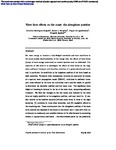Wave farm effects on the coast: The alongshore position
| dc.contributor.author | Rodriguez-Delgado, C | |
| dc.contributor.author | Bergillos, RJ | |
| dc.contributor.author | Ortega-Sánchez, M | |
| dc.contributor.author | Iglesias, Gregorio | |
| dc.date.accessioned | 2018-09-17T08:31:34Z | |
| dc.date.issued | 2018-11-01 | |
| dc.identifier.issn | 0048-9697 | |
| dc.identifier.issn | 1879-1026 | |
| dc.identifier.other | C | |
| dc.identifier.uri | http://hdl.handle.net/10026.1/12370 | |
| dc.description | publisher: Elsevier articletitle: Wave farm effects on the coast: The alongshore position journaltitle: Science of The Total Environment articlelink: https://doi.org/10.1016/j.scitotenv.2018.05.281 content_type: article copyright: © 2018 Elsevier B.V. All rights reserved. | |
| dc.description.abstract |
For wave energy to become a fully-fledged renewable and thus contribute to the much-needed decarbonisation of the energy mix, the effects of wave farms (arrays of wave energy converters) on coastal systems must be addressed. The objective of this work is to investigate the effects of wave farms on the longshore sediment transport and shoreline evolution of a gravel-dominated beach and, in particular, its sensitivity to the longshore position of the farm based on eight scenarios. Nearshore wave propagation patterns are computed by means of a spectral wave propagation model (SWAN), variations in sediment transport rates induced by the farm are calculated, and a one-line model is applied to determine the shoreline position and dry beach area. The significant wave height at breaking is reduced in the lee of the wave farm, dampening sediment transport. We find that changes in the dry beach area induced by the wave farm are highly sensitive to its alongshore position, and may result in: (i) erosion relative to the baseline scenario (without wave farm) in three of the eight scenarios, (ii) accretion in three other scenarios, and (iii) negligible effects in the remaining two. These results prove that the alongshore position of the wave farm controls the response of the beach to the extent that it may shift from accretionary to erosionary, and provide evidence of its effectiveness in countering erosion if appropriately positioned. This effectiveness opens up the possibility of using wave farms not only to generate carbon-free energy but also to manage coastal erosion, thus strengthening the case for the development of wave energy. | |
| dc.format.extent | 1176-1186 | |
| dc.format.medium | Print-Electronic | |
| dc.language | en | |
| dc.language.iso | en | |
| dc.publisher | Elsevier | |
| dc.subject | Shoreline evolution | |
| dc.subject | Coastal processes | |
| dc.subject | Erosion | |
| dc.subject | Accretion | |
| dc.subject | Wave energy | |
| dc.subject | Wave power | |
| dc.title | Wave farm effects on the coast: The alongshore position | |
| dc.type | journal-article | |
| dc.type | Journal Article | |
| plymouth.author-url | https://www.webofscience.com/api/gateway?GWVersion=2&SrcApp=PARTNER_APP&SrcAuth=LinksAMR&KeyUT=WOS:000438408800115&DestLinkType=FullRecord&DestApp=ALL_WOS&UsrCustomerID=11bb513d99f797142bcfeffcc58ea008 | |
| plymouth.volume | 640-641 | |
| plymouth.publication-status | Published | |
| plymouth.journal | Science of the Total Environment | |
| dc.identifier.doi | 10.1016/j.scitotenv.2018.05.281 | |
| plymouth.organisational-group | /Plymouth | |
| plymouth.organisational-group | /Plymouth/Faculty of Science and Engineering | |
| plymouth.organisational-group | /Plymouth/Research Groups | |
| plymouth.organisational-group | /Plymouth/Research Groups/Marine Institute | |
| plymouth.organisational-group | /Plymouth/Users by role | |
| dc.publisher.place | Netherlands | |
| dcterms.dateAccepted | 2018-05-23 | |
| dc.rights.embargodate | 2019-6-7 | |
| dc.identifier.eissn | 1879-1026 | |
| dc.rights.embargoperiod | Not known | |
| rioxxterms.versionofrecord | 10.1016/j.scitotenv.2018.05.281 | |
| rioxxterms.licenseref.uri | http://www.rioxx.net/licenses/all-rights-reserved | |
| rioxxterms.licenseref.startdate | 2018-11-01 | |
| rioxxterms.type | Journal Article/Review |


